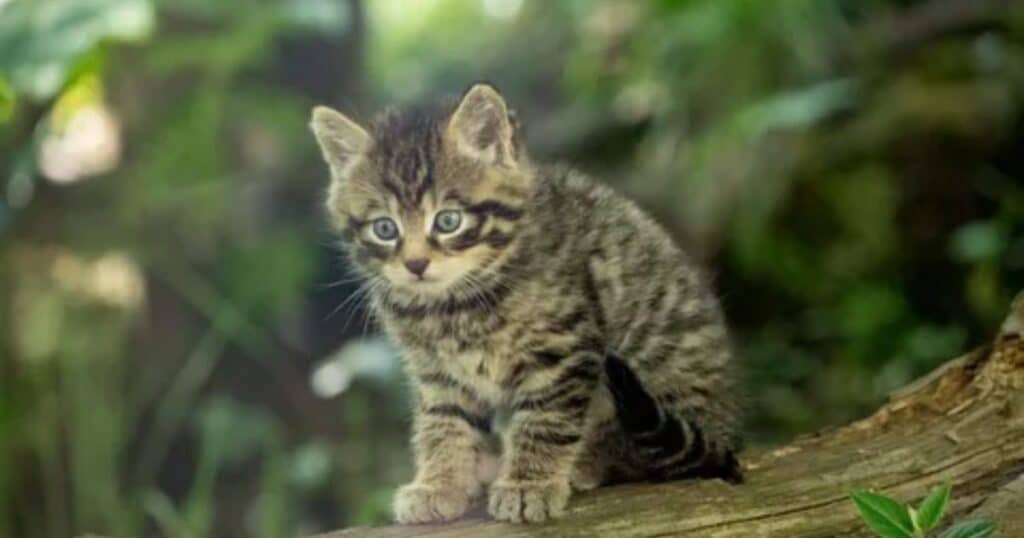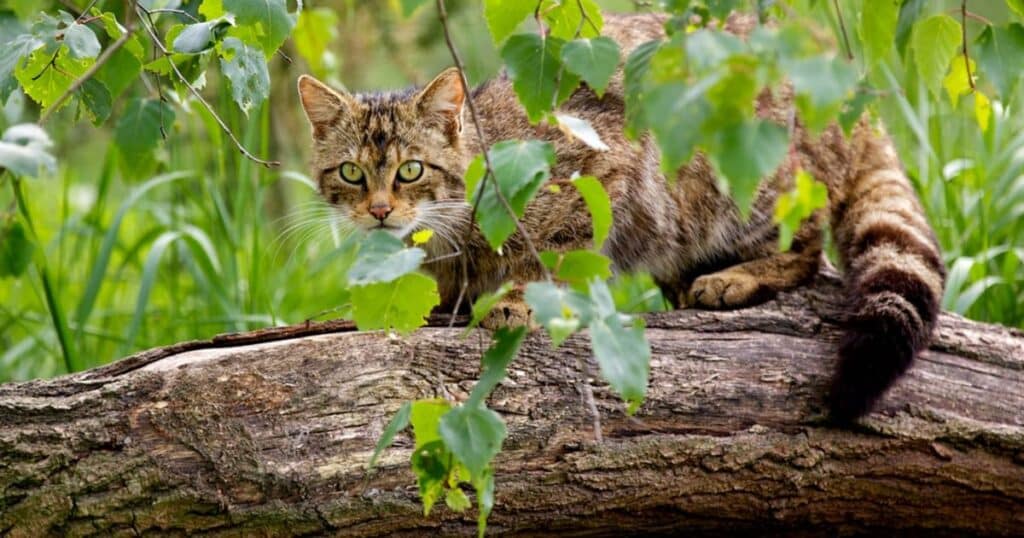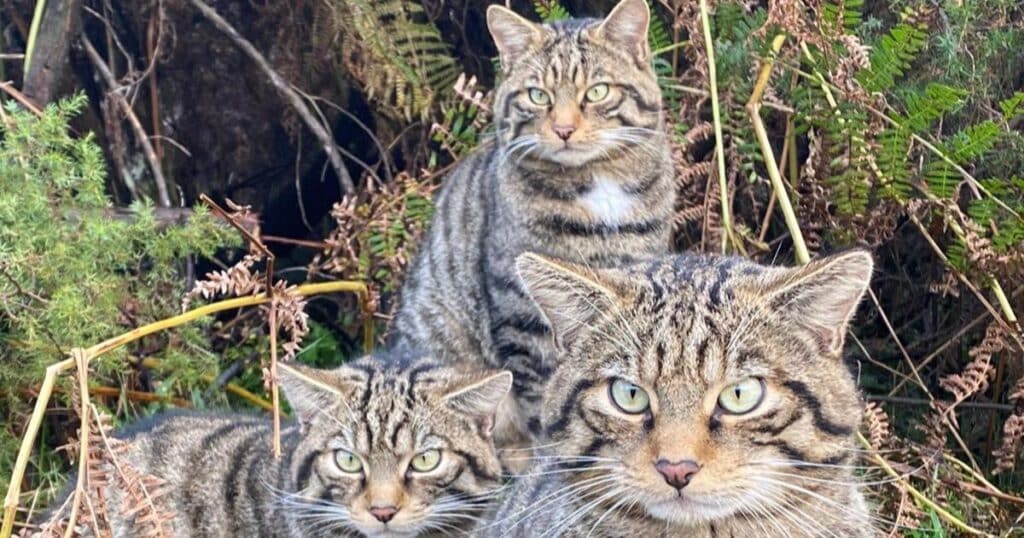In the rugged, windswept landscape of Scotland’s Cairngorms National Park, a small miracle has unfolded. For the first time in decades, kittens born to captive-bred Scottish wildcats have entered the world, igniting hope for a species teetering on the brink of extinction.
This momentous event marks a significant milestone in the ongoing efforts to save one of Britain’s most endangered mammals. Let’s dive into the captivating story of these newborn kittens and explore what their arrival means for the future of Scottish wildcats.
The Scottish Wildcat: A Species on the Brink
The Scottish wildcat, often referred to as the “Highland Tiger,” once roamed freely across the British Isles. Today, these elusive felines cling to existence in the remote corners of Scotland. Their journey to the edge of extinction is a sobering tale of habitat loss, persecution, and genetic dilution through hybridization with domestic cats.
Historically, Scottish wildcats inhabited woodlands and moorlands throughout Britain. However, centuries of deforestation, hunting, and human encroachment have decimated their population. By the early 20th century, they were confined to the Scottish Highlands, their last stronghold.
The threats facing Scottish wildcats are numerous:
- Habitat fragmentation
- Road mortality
- Competition with feral cats
- Disease transmission from domestic cats
- Accidental killing during predator control efforts
Perhaps the most insidious threat is hybridization. As wildcat numbers dwindled, interbreeding with domestic and feral cats became more common, diluting the genetic purity of the species. This genetic introgression has reached such levels that some experts question whether any genetically pure Scottish wildcats still exist in the wild.
Currently, the Scottish wildcat is classified as Critically Endangered by the International Union for Conservation of Nature (IUCN). Some estimates suggest fewer than 100 pure Scottish wildcats remain in the wild, making them one of the UK’s most imperiled mammals.
The Cairngorms: A Wildcat Stronghold
Amidst this dire situation, the Cairngorms National Park emerges as a beacon of hope. This vast wilderness, spanning over 4,500 square kilometers, provides ideal habitat for Scottish wildcats. Its diverse landscape of ancient Caledonian pine forests, heather moorlands, and deep glens offers the seclusion and prey-rich environment these cats need to thrive.
The Cairngorms’ importance for wildcat conservation cannot be overstated. It’s one of the last areas where wildcats might persist in significant numbers. The park’s remoteness and relatively low human population density reduce the risk of hybridization with domestic cats.
Several ongoing conservation projects focus on the Cairngorms, including:
- Habitat restoration initiatives
- Feral cat control programs
- Public education campaigns
- Monitoring and research efforts
These projects aim to create a safe haven for Scottish wildcats, where they can breed and potentially reestablish viable populations.
The Captive Breeding Program
Recognizing the critical state of Scottish wildcats, conservationists launched an ambitious captive breeding program. This initiative aims to preserve the genetic diversity of the species and produce a robust population for eventual reintroduction into the wild.
The program faces numerous challenges:
- Identifying genetically pure wildcats for breeding
- Maintaining genetic diversity in a small population
- Replicating natural conditions in captivity
- Preparing captive-bred animals for life in the wild
Breeding pairs are carefully selected based on genetic testing to ensure they represent the purest Scottish wildcat lineage possible. The facilities housing these cats strive to mimic natural conditions, providing ample space, hiding spots, and opportunities for natural behaviors like hunting and climbing.
Care procedures are meticulous, balancing the need for monitoring with minimal human interaction to maintain the cats’ wild instincts. Veterinary care, nutrition, and enrichment activities are all tailored to the unique needs of Scottish wildcats.
Breaking News: Kittens Born in the Cairngorms
Against this backdrop of conservation efforts, the recent birth of Scottish wildcat kittens in the Cairngorms represents a monumental achievement. These tiny felines, born to captive-bred parents, symbolize hope for the entire species.
While specific details about the birth remain confidential to protect the kittens and their parents, conservationists have confirmed that multiple healthy kittens were born. This success is particularly noteworthy given the challenges of breeding Scottish wildcats in captivity.
The significance of these births cannot be overstated. Each kitten represents a precious addition to the gene pool of this critically endangered species. Their arrival demonstrates that captive breeding can produce viable offspring, a crucial step in building a population for future reintroduction efforts.
Life of a Scottish Wildcat Kitten

Scottish wildcat kittens are born blind and helpless, weighing around 100-150 grams. They’re covered in a soft, downy fur that will gradually develop into the distinctive tabby-like coat of adult wildcats.
Here’s a table outlining key developmental milestones for Scottish wildcat kittens:
| Age | Milestone |
| Birth | Eyes closed, ears folded |
| 1-2 weeks | Eyes begin to open |
| 3-4 weeks | Begin to walk and play |
| 4-5 weeks | Start eating solid food |
| 6-8 weeks | Weaning begins |
| 10-12 weeks | Fully weaned |
| 5-6 months | Begin to hunt independently |
| 10-12 months | Reach sexual maturity |
Behaviorally, Scottish wildcat kittens are a curious blend of playfulness and ferocity. Even at a young age, they display the independent and solitary nature characteristic of their species. Play behaviors, such as pouncing and mock fighting, help develop crucial hunting skills.
Unlike domestic kittens, wildcat kittens retain a strong innate wariness of humans. This natural skittishness is crucial for their survival in the wild and must be carefully preserved in captive breeding programs.
Challenges Ahead for the Newborn Kittens
While the birth of these kittens is cause for celebration, the road ahead is fraught with challenges. Survival rates for Scottish wildcat kittens, even in captivity, are not guaranteed. In the wild, mortality rates can be as high as 70% in the first year of life.
Potential threats and obstacles include:
- Disease susceptibility
- Genetic abnormalities due to inbreeding
- Difficulty adapting to captive conditions
- Challenges in developing natural behaviors
Preparing these kittens for eventual release into the wild is a delicate process. It requires a careful balance of human care and opportunities for the kittens to develop natural behaviors and instincts. Conservationists must ensure the kittens can hunt effectively, avoid predators, and navigate their environment before any release can be considered.
The Bigger Picture: What This Means for Scottish Wildcat Conservation
The birth of these kittens in the Cairngorms represents a significant step forward for Scottish wildcat conservation. Here’s why:
- Genetic Diversity: Each new kitten adds to the genetic diversity of the captive population, crucial for maintaining the health and resilience of the species.
- Population Growth: Successful breeding in captivity is essential for building a viable population for future reintroduction efforts.
- Public Interest: News of wildcat kittens can spark public interest and support for conservation efforts, leading to increased funding and volunteer participation.
- Scientific Knowledge: Each birth provides valuable data on Scottish wildcat reproduction, aiding future conservation strategies.
- Hope: Perhaps most importantly, these kittens represent hope – tangible proof that with dedicated effort, we can make a difference in saving this iconic species.
How You Can Help Scottish Wildcats

The fight to save the Scottish wildcat is far from over, and public support is crucial. Here are ways you can contribute:
- Donate: Organizations like Scottish Wildcat Action and the Royal Zoological Society of Scotland accept donations to support their conservation efforts.
- Volunteer: Many conservation projects offer volunteer opportunities, from habitat restoration to public education initiatives.
- Spread Awareness: Share information about Scottish wildcats on social media, or organize educational events in your community.
- Responsible Pet Ownership: If you live in or near Scottish wildcat areas, ensure your domestic cats are neutered and vaccinated to prevent hybridization and disease transmission.
- Support Local Conservation: When visiting Scotland, choose eco-friendly accommodations and tours that support wildlife conservation.
Conclusion
The birth of Scottish wildcat kittens in the Cairngorms is more than just a heartwarming story – it’s a crucial milestone in the fight to save a species. These tiny felines, with their distinctive tabby coats and fierce spirits, embody the resilience of nature and the power of dedicated conservation efforts.
As we celebrate this small victory, we must also recognize the long road ahead. The Scottish wildcat’s journey back from the brink of extinction will require continued research, funding, and public support. But with each kitten born, each hectare of habitat restored, and each person educated about these remarkable animals, we move one step closer to ensuring the “Highland Tiger” continues to roam the wilds of Scotland for generations to come.
The story of these kittens born in the Cairngorms to captive-bred Scottish wildcats is not just about conservation – it’s about preserving a piece of Scotland’s natural heritage, maintaining the delicate balance of ecosystems, and demonstrating our capacity as humans to right the wrongs of the past. It’s a story of hope, perseverance, and the incredible resilience of nature when given a chance to thrive.
ALSO READ THIS POST: Understanding Common Cat Sleeping Positions When Sick
FAQ’s
Can Scottish wildcats breed with domestic cats?
Yes, Scottish wildcats can breed with domestic cats. This interbreeding, known as hybridization, is actually one of the major threats to the Scottish wildcat’s survival. The resulting hybrid offspring dilute the pure wildcat gene pool, contributing to the decline of genetically pure Scottish wildcats in the wild.
Why are Scottish wildcats going extinct?
Scottish wildcats are facing extinction due to a combination of factors. The main threats include habitat loss, hybridization with domestic cats, accidental killing during predator control efforts, and diseases transmitted by domestic cats. Human expansion and land use changes have also significantly reduced their natural habitat over the centuries.
How many pure Scottish wildcats are left?
The exact number of pure Scottish wildcats remaining is uncertain and hotly debated among experts. Conservative estimates suggest there may be fewer than 100 genetically pure individuals left in the wild. Some researchers even argue that no truly pure Scottish wildcats may remain, highlighting the critical state of the species.
What is the difference between a Scottish wildcat and a tabby cat?
While Scottish wildcats and tabby cats may look similar at first glance, there are key differences. Scottish wildcats are larger, with thicker fur, a bushier tail with distinct black rings, and a blunt, black-tipped tail. They also have a distinctive “tiger” stripe along their spine and sides, and a more muscular build compared to domestic tabbies.
What is the friendliest wild cat?
The concept of “friendliness” doesn’t really apply to wild cats as they’re not domesticated. However, some wild cat species, like cheetahs, are known to be less aggressive towards humans. Scottish wildcats, the focus of our discussion, are decidedly not friendly and are known for their fierce, untameable nature, even when raised in captivity.
How long does a Scottish wildcat live?
In the wild, Scottish wildcats typically live for 6-8 years, though some may reach up to 12 years. In captivity, where they’re protected from many natural threats, they can live significantly longer, with some individuals reaching 15-20 years of age. However, their lifespan in the wild is often cut short due to various threats they face.

Davin Connor is an experienced author with 3 years in pets writing. Known for concise, informative content, he shares expertise on pet care, behavior, and health through his engaging articles.






